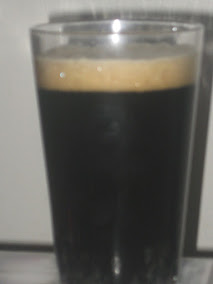In its own way, Black Forest Porter represents what I think is a very positive aspect of craft brewing. Craft breweries approach traditional beer styles with a lot of creativity and innovation. Medicine Hat decided to combine two of their beers to create something new: a porter with flavors of chocolate and cherry. In my days as a home brewer, I often thought of doing something similar in the hopes of making a beer that had the characteristics of a black forest cake.
When I saw this beer on the shelves I had a picture in my head of what this beer might taste like. I pictured the flavors of chocolate and roasted coffee present in my favorite porters. I thought about flavors of black cherry, such a natural compliment for those flavors of chocolate. Since I had a passing familiarity with Medicine Hat Brewing, I thought I ought to give this beer a chance. Black Forest Porter is thick, and black as pitch. The head is packed, cream colored, and lasting.
As expected, Black Forest has gentle maltiness up front combined with aromas of not over-sweet chocolate cake. Chocolate cake is supported by a thin layer of black cherry, giving this porter its obligatory aroma of black forest cake. Hints of earthiness in the center carry the aromas through to a finish where I note aromas of roasted coffee. A little bit of leafy hop in the finish before it fades into the background.
Taking a sip, Black Forest Porter is smooth, full bodied, and offers an up front milk chocolate sweetness. Chocolate sweetness is followed by a too brief shot of black cherry before moving into a roasted center. The roasted flavor is more roasted grain than the roasted coffee I was expecting. The finish is short, dry, and fades quickly into the background.
I'm giving Black Forest Porter 6.5 out of 10. It smells good, and it tastes alright as porters go. My main issue with this porter is it doesn't have enough of either the porter character I was looking for, or the black forest cake I was hoping for, either. To my tongue, it tastes as though they wanted to make a "safe" version of what should have been an innovative take on a style of beer.











